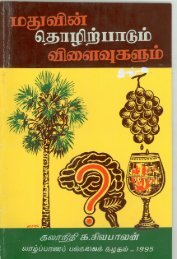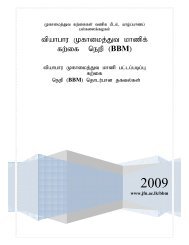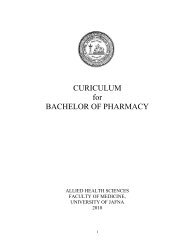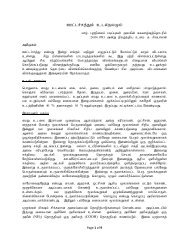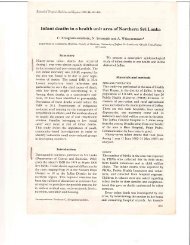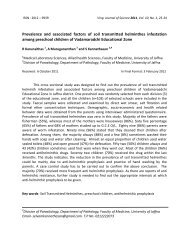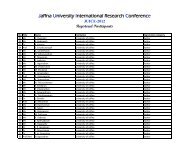MANUAL PHYSIOLOGY PRACTICAL - Repository:The Medical ...
MANUAL PHYSIOLOGY PRACTICAL - Repository:The Medical ...
MANUAL PHYSIOLOGY PRACTICAL - Repository:The Medical ...
You also want an ePaper? Increase the reach of your titles
YUMPU automatically turns print PDFs into web optimized ePapers that Google loves.
FM/UOJ<br />
Experiment C 2<br />
MEASUREMENT OF BLOOD PRESSURE<br />
Blood pressure is the lateral pressure exerted by the blood on the artery wall at<br />
the level of the heart. In experimental animals this can be measured by connecting a<br />
manometer directly to the artery. <strong>The</strong> blood pressure of man is measured by an indirect<br />
method; a measurable pressure is applied over the artery; the pressure required to<br />
compress the artery is equal to the pressure. Measuring blood pressure is an accurate<br />
and simple method of assessing the state of the circulatory system.<br />
<strong>The</strong> main aim of this practical is to gain skill in measuring blood pressure<br />
accurately<br />
Instruments:<br />
Sphygmomanometer and stethoscope.<br />
Method:<br />
Make sure that the subject (or patient) is comfortably seated or in bed and in a<br />
relaxed condition. Remove cloths from the arm and apply the cuff.<br />
Application of the cuff:<br />
Blood pressure is generally recorded in the arm with the patient in sitting or<br />
recumbent position. <strong>The</strong> artery over which the pressure is to be measured should be at<br />
the level of the heart. <strong>The</strong> deflated compression cuff is applied evenly and snugly but<br />
without constriction around the arm. <strong>The</strong> lower edge of the cuff should be about 2.5 cm<br />
above the elbow joint. Make sure that the middle of the rubber bag is over the brachial<br />
artery, in the medical aspect of the arm.<br />
Palpatory method of measurement:<br />
This method is based on the fact that the pulse wave is not conducted through<br />
when the brachial artery is occluded. This happens when the external pressure (in the<br />
cuff) is more than the maximum pressure in the artery.<br />
First, locate and palpate the redial or brachial pulse. While feeling the pulse by<br />
one hand, inflate the cuff by the other hand. Continue to increase the pressure for about<br />
further 30 mm Hg after the disappearance of the pulsation. Deflate the cuff slowly<br />
(about 2 or 3 mm Hg per second) until the pulse is felt again. <strong>The</strong> pressure at this<br />
moment is equal to the systolic blood pressure.<br />
Auscultatory method of measurement:<br />
This method is based on sounds produced at the lower end of the partially<br />
compressed artery due to turbulence. If the pressure in the cuff exceeds systolic<br />
pressure the artery is closed and there will be no sound. If the pressure in the cuff is<br />
below the diastolic pressure also there will be no sound because the artery is fully<br />
opened and there is laminar flow. When the cuff pressure is between systolic and<br />
Circulation<br />
Page | 85



